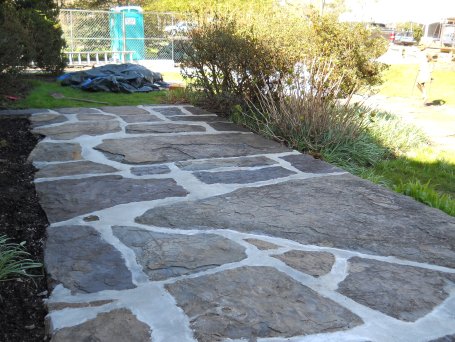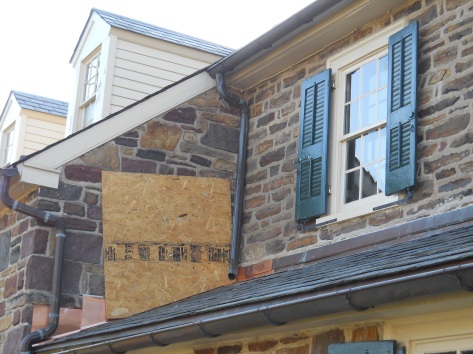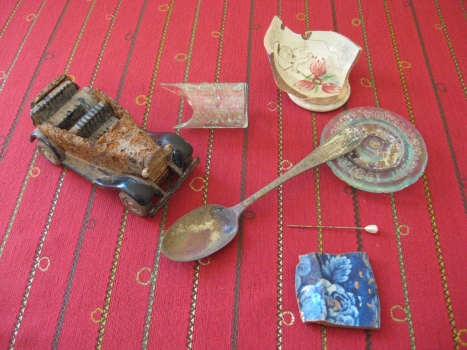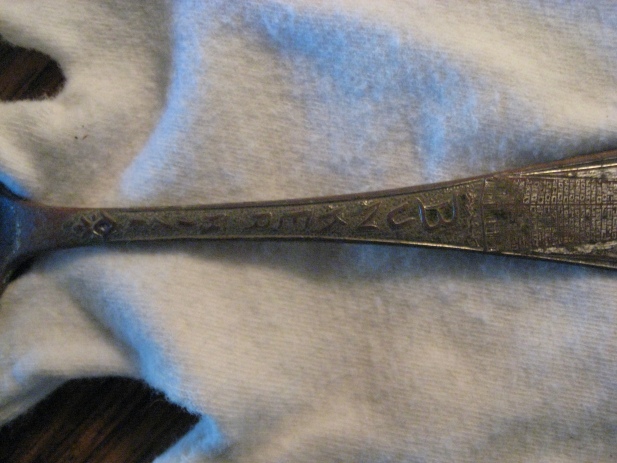As of mid April 2012, our scheduled exterior restoration work is right on target thanks in part to a very mild winter and virtually rain-free spring. The cement walkway was installed alongside the west end of the House; in front of the large picture window of the kitchen.
All exterior terra-cotta drainage pipes connected to the House at various points within the upper and lower flagstone terraces were removed and a new pipe designed for gravity flow drainage applications was installed. A few of the former downspout boots were replaced as well to increase the efficiency and effectiveness of the drainage system.
The subsurface of the upper terrace was closed back up, leveled off with stones, and a cement base was poured whereby increasing future stability of the flagstones once reinstalled and pointed. You will see the cement subsurface has been encoded with blue letters which correspond to the quadrants of flagstones which were carefully catalogued prior to removal.
As a result of ongoing water infiltration issues, several sections of the slate roof of the Pearl S. Buck House were identified for full replacement. The slate roof covering the Mud Room located at the southwestern end of the House was removed and ice and water shield will be installed prior to the application of a new slate roof.
The northern exposure of the Small Library roof also had its slate removed, and ice and water shield and underlayment installed prior to the application of new copper flashing and slate roof.
The northern terrace, which once supported the Walsh family’s access to the House through the Foyer doorway, was re-pointed to enhance visitors’ experiences as they tour the beautiful gardens, foliage and award winning pond installed by Pearl S. Buck.
A second floor window located on the northeastern side of the home, providing daylight into the former children’s bathing room, referred to as the Yellow Bathroom was removed in preparation for a modification to the structure. The proximity of the window to the slate roof over the first floor Living Room did not allow for adequate flashing to be installed where this window met the roof line. As a result, water infiltration has plagued this area of the home and negatively impacted the custom built phonograph storage cabinet located in the northeastern corner of the living room. The cabinet will be restored during Part B of this project. In addition, one of Pearl S. Buck’s tiehua (iron strip hammered sculpture that originated in the Wuhu province of China) which once hung in this corner was also damaged by water infiltration and is now stored in our archives awaiting restoration when funding becomes available.
A smaller window opening will be created and a new window will be installed, allowing for proper flashing and water run-off. The renovations to the Yellow Bathroom window will be virtually unnoticeable to visitors as the interior finishes of the window sill will be reframed and the built-in cabinetry will remain intact to the period of the Walsh family’s occupancy.
During this period of work additional artifacts were unearthed and included a toy car with rubber wheels and dark blue plastic side runners, since identified as a 1931 Plymouth Chrysler Convertible produced by Tonka toys circa 1972. The car was seemingly tucked away, perhaps to be unearthed in the future, behind a stone in a low masonry garden wall of the upper terrace. The former debris pit located in the lower terrace revealed more treasures as follows: additional pottery shards, broken glass, a glass lid with raised letters of Whitehall’s Patent June 18th, 1861 was found and determined to be a canning jar lid missing the side iron clamps and glass carafe type base; a Pearl tip stainless steel hat pin and a commemorative spoon from Bunker Hill Memorial, noting the battle date, 1775 Bunker Hill on the spoon shaft. The spoon appears to be brass under a layer of silver color wash. Additional information is being sought from spoon collectors as no makers’ markings were found. We continue to encourage you to return to the virtual exhibit to see what other treasures may surface.














Leave a comment